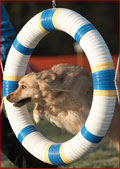Police Service Dogs Have Proven To Be An Important Tool For Law Enforcement Officers
From: TulsaWorld.com
Once a day on average, an Oklahoma Highway Patrol drug dog walks around a vehicle that has been stopped for a traffic violation.
Sometimes the dog has been deployed because the driver declined a request by the trooper to search the vehicle for drugs. Other times the trooper, in the interest of time, will deploy the dog without asking the driver.
If the dog senses one of the illegal drugs it has been trained to detect — marijuana, heroin, cocaine or methamphetamine — the animal will signal to its handler.
Sometimes the dog will try to get as close as it can to the smell, even jumping through an open window if possible.
Such details about drug dog searches were included in records obtained earlier this year by the Tulsa World from the Department of Public Safety. The World obtained the records as a result of a 2001 lawsuit that was settled earlier this year.
A World review of more than 300 OHP drug dog usage reports from 2008 indicates:
OHP dogs detected drugs in 80 percent of the vehicles they searched.
In 39 percent of the stops in which a dog detected drugs, no narcotics were found.
Sometimes the dogs find large amounts of drugs, but most often the amount is small, sometimes described as "personal use" amounts or just "residue."
White motorists stood a lesser chance of being searched, but were more likely to be found with drugs compared with Hispanics.
One longtime critic of the use of drug dogs says the state has operated for years under a flawed drug dog certification process.
Dogs cashing in
With three major interstate highways crisscrossing the state, law enforcement officials have long said Oklahoma is a major thoroughfare for drug trafficking.
To combat traffickers, troopers from the OHP special operations unit look for drug couriers while patrolling Interstates 44, 40 and 35 in addition to other highways such as U.S. 69 in southeastern Oklahoma.
In 2008, the special operations unit made 217 interdictions and seized nearly 2 tons of marijuana, 90 pounds of cocaine, 13 pounds of crystal methamphetamine and 18 pounds of heroin. The unit also seized an estimated $10.7 million in cash linked to drug trafficking, according to OHP records.
Of that amount, nearly $4 million in cash was attributed to finds made by drug dogs, according to a World analysis of drug dog use records.
Half of the $4 million total attributed to OHP drug dog searches was seized during one traffic stop in March 2008 along I-40 near El Reno.
Other cash amounts seized in 2008 following drug dog searches ranged from $4,500 to $386,000.
Troopers decide on a case-by-case basis whether to use a drug dog during a traffic stop, said OHP Lt. Brett Key.
"There's a lot of different things that goes into it, but a majority of the time it's when we are refused consent (to search the vehicle)," Key said.
Of the 330 times that a drug dog was utilized in 2008 for OHP traffic stops, the animal indicated the presence of drugs in 80 percent of the searches, a World review of usage records shows.
Drugs and large sums of cash associated with drug trafficking were not always found in cases where a dog indicated their presence. In fact, drugs were not located in 39 percent of the dog-initiated searches, a World analysis indicates.
"There's times when the dog will alert and we don't find anything," Key said.
Key said just because an officer doesn't find drugs when a dog alerts, that doesn't mean the animal was wrong.
Sometimes the dog is smelling a residual odor after drugs have been used or transported in a vehicle, he said.
"Well, those dogs have super-sensitive noses and can still pick that up," Key said.
Large amounts of drugs or cash were found in 17 percent of the dog-initiated searches.
"If we stop them and they only have that personal use, then, hey, you know what, we'll take it, because whether they are using at the time or later on they are still a threat to the public," Key said.
A World analysis of the race of the drivers found that OHP drug dogs were more likely to be used to search vehicles driven by Hispanics and blacks than white drivers.
Hispanic and black drivers comprised 23 percent and 24 percent, respectively, of the vehicles in which the OHP conducted dog-initiated searches in 2008. Hispanics and blacks each comprise 7 percent to 8 percent of the total state population.
The OHP, meanwhile, was more likely to find drugs or cash among whites and blacks, about 65 percent of the cases, than among Hispanics, where narcotics or cash were found in 52 percent of the drug-initiated searches.
Key says the OHP does not profile drivers.
"That's something that's out of our control as far as who has it and if we are in the middle of a stop and whether they are white, black, Hispanic or Asian and there are criminal indicators or they are not being honest with us that raises flags with us," Key said.
"But anymore you can't profile per se because it doesn't discriminate anymore," Key said, referring to drug traffickers. "If you are profiling, you are missing it."
Standards changed
Meanwhile, an Oklahoma City criminal defense attorney said he has been challenging the OHP and other agencies for years on their use of drug dogs.
Doug Parr, a former president of the Oklahoma Criminal Defense Lawyers Association, said drugs dogs can be accurate at finding illegal substances.
"A well-trained drug dog is something that is astonishing to see work," Parr said.
But Parr says drug dogs in Oklahoma haven't been properly certified for years.
"I have not found a single case in the six or seven years that I have been working on this where any dog has ever been presented, for certification testing, a situation where they knew there were no drugs present," Parr said.
Such information is important, Parr said, to ensure a dog is not alerting when in fact drugs are not present.
Parr maintains that the Council on Law Enforcement Education and Training, the state agency responsible for certifying all drug detection dogs, has not been following its own rules when it comes to licensing the animals for use in the field.
Parr said he challenged a CLEET certification requirement that limited drug dogs to a "false response" rate of not more than 20 percent.
"Their response to the fact that every drug dog in the state of Oklahoma did not meet the certification rules that they had set up was to change the rules," Parr said.
Indeed, records on CLEET's Web site indicate drug dog certification standards changed in July.
The changes included removing a requirement that a drug dog score an 80 percent or higher "find" rate and not more than a 20 percent "false response" rate.
Now a drug dog becomes certified after it "passes the certification test," Parr said.
CLEET spokesman Steve Emmons said the Oklahoma Bureau of Narcotics and Dangerous Drugs administers the drug dog certification tests. CLEET licenses 320 to 350 dogs and their handlers during an average year, Emmons said.
CLEET changed the rules regarding dog certification testing to align with Oklahoma Bureau of Narcotics and Dangerous Drugs testing protocol, Emmons said.
"The state statutes designate that CLEET will be the licensing agency for drug dogs, and as such we don't do the test," Emmons said. "We rely upon OBNDD to do the testing for it, and we license it."







 Ontario Dog Sports
Ontario Dog Sports
Reader Comments